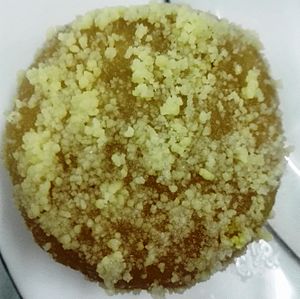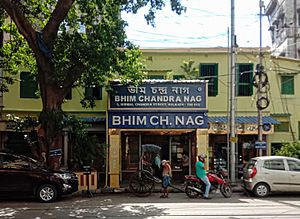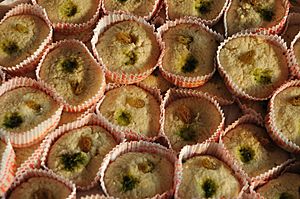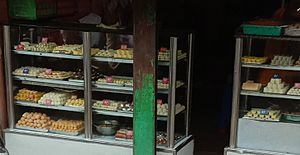Sandesh (confectionery) facts for kids

|
|
| Course | Dessert |
|---|---|
| Place of origin | Indian subcontinent |
| Region or state | Bengal region of the Indian subcontinent |
| Associated national cuisine | Bangladesh, India |
| Main ingredients | Chhena, sugar, jaggery (gur), condensed milk |
| Variations | Nolen guṛer sondesh, norom pak sondesh, koṛa pak sondesh, various flavorings |
Sandesh (pronounced Shôndesh) is a yummy dessert from the Bengal region. This area is in the eastern part of the Indian subcontinent. Sandesh is mostly made from milk and sugar.
Some types of sandesh use a special cheese called chhena or paneer. This cheese is made by curdling milk. Other kinds of sandesh are made with mawa and yogurt. There's even a famous style from Guptipara called Gupo sandesh. Some people think it was the first "branded sweet" from Bengal!
A Sweet History
Sandesh is a very old sweet. People wrote about a sweet called sandesh in old Bengali stories. These stories include the Krittivasi Ramayan and writings by Chaitanya Mahaprabhu.
We don't know exactly what was in those old sweets. They were probably different from the sandesh we eat today. The original sandesh was likely made from a thick milk product called kheer.
It's not clear when sandesh started being made with chhena. But by the late 1800s, most people knew sandesh as the sweet made with chhena.
How Sandesh is Made
Sandesh is usually made using chhena, which is like cottage cheese. The simplest kind is called makha sandesh. Makha means 'kneaded'. To make it, chhena is gently mixed with sugar over low heat.
When this mixture is shaped into balls, it's called Kanchagolla. Kancha means 'raw' and golla means 'ball'. For more fancy sandesh, the chhena is dried and pressed. It can be flavored with fruit or even colored.
Sometimes, sandesh is filled with syrup. It can also be mixed with coconut or kheer. Makers often shape sandesh into fun forms. These include conch shells, elephants, and fish.
Another popular type is nolen gurer sandesh. This one uses gur, which is a type of jaggery. It has a special brown or caramel color from the nolen gur.
See also
 In Spanish: Sandesh para niños
In Spanish: Sandesh para niños






